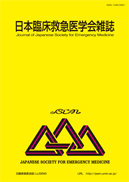Volume 21, Issue 3
Displaying 1-12 of 12 articles from this issue
- |<
- <
- 1
- >
- >|
-
2018Volume 21Issue 3 Pages ii
Published: June 30, 2018
Released on J-STAGE: June 30, 2018
Download PDF (93K)
REVIEW
-
2018Volume 21Issue 3 Pages 471-477
Published: June 30, 2018
Released on J-STAGE: June 30, 2018
Download PDF (453K)
ORIGINAL ARTICLES
-
2018Volume 21Issue 3 Pages 478-487
Published: June 30, 2018
Released on J-STAGE: June 30, 2018
Download PDF (486K) -
2018Volume 21Issue 3 Pages 488-497
Published: June 30, 2018
Released on J-STAGE: June 30, 2018
Download PDF (550K) -
2018Volume 21Issue 3 Pages 498-503
Published: June 30, 2018
Released on J-STAGE: June 30, 2018
Download PDF (385K) -
2018Volume 21Issue 3 Pages 504-512
Published: June 30, 2018
Released on J-STAGE: June 30, 2018
Download PDF (616K)
RESEARCHES
-
2018Volume 21Issue 3 Pages 513-518
Published: June 30, 2018
Released on J-STAGE: June 30, 2018
Download PDF (782K)
CASE REPORTS
-
2018Volume 21Issue 3 Pages 519-522
Published: June 30, 2018
Released on J-STAGE: June 30, 2018
Download PDF (374K) -
2018Volume 21Issue 3 Pages 523-527
Published: June 30, 2018
Released on J-STAGE: June 30, 2018
Download PDF (559K) -
2018Volume 21Issue 3 Pages 528-533
Published: June 30, 2018
Released on J-STAGE: June 30, 2018
Download PDF (363K) -
2018Volume 21Issue 3 Pages 534-537
Published: June 30, 2018
Released on J-STAGE: June 30, 2018
Download PDF (515K)
-
2018Volume 21Issue 3 Pages 544
Published: June 30, 2018
Released on J-STAGE: June 30, 2018
Download PDF (145K)
- |<
- <
- 1
- >
- >|
